





The GRIN Website lists 24 species of Plectranthus. However, other references suggest that more than 350 species are known. Obviously much reclassification of the genus has taken place, and even the ubiquitous coleus, until recently known as Solenostemon scutellarioides, is now in the Plectranthus genus.
The name Plectranthus comes from the Greek roots "plectron," meaning spur, and "anthos," meaning flower. Many are called spur flowers, referring to the spur that is often at the base of the petals. All Plectranthuses are members of the Lamiaceae (mint) family. Most are native to regions of Africa, Asia, and Australia. Members of the genus serve various purposes in the landscape, and some are used as food, medicine, and as an air purifier. Some people believe that certain kinds scare away snakes and repel mosquitoes.
For instance, Plectranthus esculentus (dazo, finger potato, Livingstone potato) is grown for its edible tubers, and P. rotundifolius (Hausa potato, frafra potato, Sudan potato, coleus potato, Zulu potato) is grown for its edible foliage and tubers. Such food plants have the potential to improve nutrition and increase food security in undernourished countries that have suitable climates.
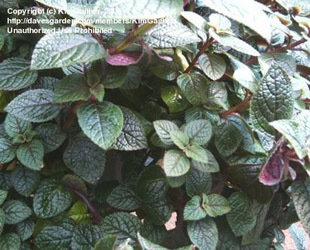 Plectranthus purpuratus is a tender perennial that smells like Vick's Vaporub. Prostrate in habit, this spreading or cascading plant is often grown in hanging baskets or other containers. Dark-green elongated, oval, sharp-tipped, fuzzy leaves with serrated edges are attractive, particularly when purplish new leaves are present. In frost free climates the plants make an effective groundcover. This attractive plant goes by such common names as moth king Plectranthus, purple Swedish ivy, purple spur flower, and Vicks plant. Small pale purple flowers bloom throughout the year. Variegated types are available, as well.
Plectranthus purpuratus is a tender perennial that smells like Vick's Vaporub. Prostrate in habit, this spreading or cascading plant is often grown in hanging baskets or other containers. Dark-green elongated, oval, sharp-tipped, fuzzy leaves with serrated edges are attractive, particularly when purplish new leaves are present. In frost free climates the plants make an effective groundcover. This attractive plant goes by such common names as moth king Plectranthus, purple Swedish ivy, purple spur flower, and Vicks plant. Small pale purple flowers bloom throughout the year. Variegated types are available, as well.
Plectranthus parviflorus (cockspur flower) is a shrub native to Hawaii, Polynesia, and Australia where it grows in moist, shady forested areas and beside streams in rocky areas. Unlike most other members of the genus, it has no scent. Light green, fleshy leaves are fuzzy, oval, and have scalloped edges. Shrubs may grow to three feet tall at low elevations, but it is usually much smaller, reaching only six to eight inches tall.
Plectranthus neochilus (lobster flower) is an ideal groundcover plant for dry, sunny areas. Gray-green, rounded, slightly scalloped leaves are attractive, but the skunk-like aroma carries for quite a distance on hot, sunny days. Ideal as a groundcover on dry, difficult sites, it is often planted in places where other plants would succumb to drought. Stems root easily and spread to make tidy clumps less than one foot tall. Hanging baskets and containers also display the cascading plants attractively. Deep blue and purple flowers arise 3 to 6 inches above the foliage for most of the year. Lobster flower is hardy in Zones 9-11, but it is often grown as an annual in other areas. ‘Fuzzy Wuzzy' is a variegated cultivar.
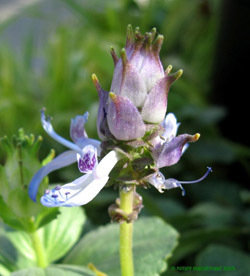
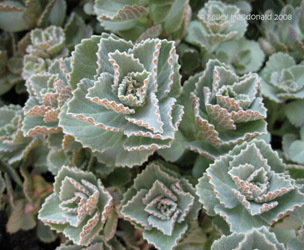
Cuban oregano (Plectranthus amboinicus) is a widely grown plant. Sometimes called Spanish thyme, Mexican thyme, and Indian borage, the aromatic, edible leaves have a flavor suggestive of a combination of oregano and thyme. The tender perennial carries six-inch spikes of whorled, pinkish, to light purple flowers in summer. Plants grow between one and three feet tall and wide a sport thick, velvety, succulet foliage. Bring plants inside for winter where freezing weather occurs. Tip cuttings root quickly, so new plants are easy to start.
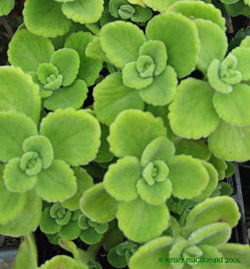
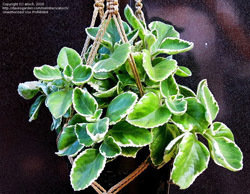
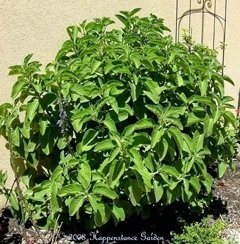 Plectranthus barbatus (Indian coleus) can grow a whopping 10 feet tall. Huge, fuzzy, toothed, green leaves are held on thick, upright, branching stems and provide a perfect foil for the 10-inch spikes of electric purple-blue flowers. The plants tolerate full sun, low water, and appalling neglect, but temperatures below 32°F will level them. P. barbatus var. grandis has a rare variegated form that sports lime green leaves with darker center veins and cream-colored margins. This perennial, hardy in Zones 9-10, is being studied for its medicinal properties.
Plectranthus barbatus (Indian coleus) can grow a whopping 10 feet tall. Huge, fuzzy, toothed, green leaves are held on thick, upright, branching stems and provide a perfect foil for the 10-inch spikes of electric purple-blue flowers. The plants tolerate full sun, low water, and appalling neglect, but temperatures below 32°F will level them. P. barbatus var. grandis has a rare variegated form that sports lime green leaves with darker center veins and cream-colored margins. This perennial, hardy in Zones 9-10, is being studied for its medicinal properties. 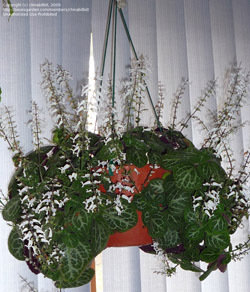
Blue spur flower (Plectranthus oertendahlii), also known as speckled spur flower or candlestick plant, is a low-growing selection that is at home in the low light of the forest floor. It can successfully compete for nutrients and moisture underneath trees. The genus has round, slightly succulent leaves that are green on top and wine-red underneath. Cultivars such as ‘Silver Stars', ‘Royal Beauty', and ‘Limelight' have been selected for their attractive foliage and long season flowering and are popular houseplants.
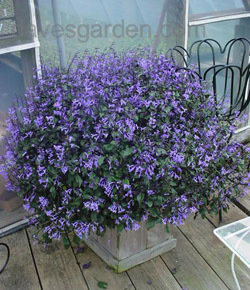 A fairly recent introduction is Plectranthus 'Mona Lavender'. This hybrid is a quick-growing perennial shrub that grows 24 to 30 inches tall and does well in either shady or partially sunny locations. Those grown in sun are more compact and the purple color on the undersides of the leaves is much more intense. Spikes of dark lavender flowers bloom from spring until fall. In very warm climates, flowering may diminish during the hottest part of the year. People who have very bright spots indoors may enjoy blooms during the winter. ‘Mona Lavender' has been highly promoted by the retail industry and is available at most garden centers.
A fairly recent introduction is Plectranthus 'Mona Lavender'. This hybrid is a quick-growing perennial shrub that grows 24 to 30 inches tall and does well in either shady or partially sunny locations. Those grown in sun are more compact and the purple color on the undersides of the leaves is much more intense. Spikes of dark lavender flowers bloom from spring until fall. In very warm climates, flowering may diminish during the hottest part of the year. People who have very bright spots indoors may enjoy blooms during the winter. ‘Mona Lavender' has been highly promoted by the retail industry and is available at most garden centers.
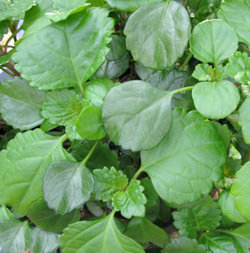 One that I have grown and enjoyed for years is Plectranthus australis. Since it is not listed on the GRIN website, it may have been reclassified. Commonly called Swedish ivy, the plant has glossy, green, quilted leaves with scalloped edges and is particularly effective in hanging baskets. Tubular lilac and white flowers bloom during the summer. This plant overwinters in my Zone 8B garden in protected places. I start new baskets of it each summer from plants that survived in the greenhouse and from sprigs found under azalea and camellia bushes in the garden.
One that I have grown and enjoyed for years is Plectranthus australis. Since it is not listed on the GRIN website, it may have been reclassified. Commonly called Swedish ivy, the plant has glossy, green, quilted leaves with scalloped edges and is particularly effective in hanging baskets. Tubular lilac and white flowers bloom during the summer. This plant overwinters in my Zone 8B garden in protected places. I start new baskets of it each summer from plants that survived in the greenhouse and from sprigs found under azalea and camellia bushes in the garden.
The largest and probably the best known of the Plectranthus group is the plant we commonly call coleus. For many years, the genus and species of this plant was Coleus blumei. From there it went to Solenostemon scutellarioides, but recently the name has been changed to Plectranthus scutellarioides. Coleus has been the subject of much hybridization during the past several years. Plants can be found in almost any color, size, and form that can be imagined. More information about coleus is available at Dave's Garden.
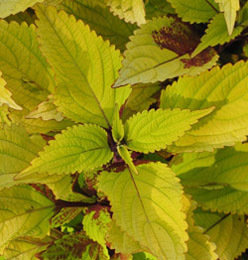
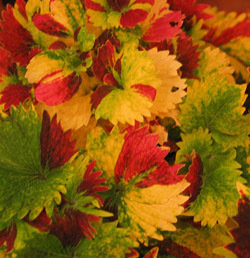
Most members of the Plectranthus genus are easily propagated by cuttings. Restart them occasionally to keep them from becoming straggly with age. Pinching encourages plants to produce more branches and to become fuller and denser. Nematodes are especially fond of their root systems, so starting new plants from cuttings and moving them to a different spot in the landscape can invigorate declining plants.
Other species exist and are commonly grown. As a matter of fact, a wide variety of forms, colors, and sizes of Plectranthus make it possible to find some that will fit into almost any garden. Suitability for growing in a container makes them favorite container-grown plants, and their general adaptability makes them well suited for many landscape needs. Generally speaking, for almost any garden situation, a plectranthus can be found to fit the bill.
Thanks to the many people who contribute their photos to Dave's Garden. They are a great help to all who visit the site and particularly to writers who use them with their articles. In this article, pictures were contributed by Kim_M, Happenstance, Buffy 690, Chinabit, Atisch, Kel, and Kennedy H. Pictures not credited are the author's. Mouse over pictures for specific credits.Copyright © www.100flowers.win Botanic Garden All Rights Reserved